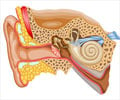Researchers have revealed that while the recommendation to lay babies on their backs to sleep has reduced sudden infant death syndrome (SIDS), it has led to an increased number of infants with a skull deformity called deformational plagiocephaly.
Now new research suggests that infants with more severe plagiocephaly may have a higher rate of middle ear abnormalities associated with ear infections (otitis media), reports the September issue of The Journal of Craniofacial Surgery. The journal is published by Lippincott Williams & Wilkins, a part of Wolters Kluwer Health, a leading provider of information and business intelligence for students, professionals, and institutions in medicine, nursing, allied health, and pharmacy.Given the potential impact on hearing and other aspects of child development, more research will be needed to clarify the risk of otitis media in infants with deformational plagiocephaly, according to researcher Adam Purzycki, BS, and colleagues of Wake Forest University Medical Center, Winston-Salem, NC.
Results Suggest Possible Increase in Otitis Media with Severe Plagiocephaly
Children with deformational plagiocephaly have flattening of the back of the head, ranging from mild to severe. In recent years, the number of infants with this form of plagiocephaly has increased exponentially as a result of the "Back to Sleep" campaign to prevent SIDS. The growing skull becomes deformed as a result of pressure from lying in the same position. For most affected infants, treatment consists of a helmet or band to gently mold the growing skull into a more normal shape.
The researchers asked the parents of 1,259 children with deformational plagiocephaly about their child''s history of ear infections. Almost exactly half of the children had at least one ear infection before one year old-similar to the rate in the normal population. The rate was slightly higher for children with more severe plagiocephaly: 54 percent, compared to 49 percent in those with milder deformity.
In 124 children, the researchers performed a test called a tympanogram, done to measure pressures within the middle ear. Certain patterns of tympanogram results suggest the presence of otitis media.
The results showed "a marked trend" toward a relationship between otitis media-related abnormalities and the severity of plagiocephaly. "The more severe cases (types IV-V) of plagiocephaly had a higher percentage of otitis media than the less severe cases (types I-III)," the researchers write.
Hearing Loss Could Contribute to Developmental Problems
In more severe plagiocephaly, the skull deformity may cause the ear to move forward. Resulting abnormalities of the eustachian tube may cause problems with fluid drainage from the middle ear, promoting infections and otitis media. "The significantly high percentage of tympanogram readings that pointed to otitis media…suggests an overall malfunction of the middle ear drainage function of the eustachian tube in these children," according to Purzycki and colleagues.
Advertisement
If so, then recognition and appropriate management of otitis media in children with deformational plagiocephaly might help to reduce these long-term developmental concerns. However, the researchers emphasize the need for more research to clarify the link between plagiocephaly and otitis media-including the clinical significance of the abnormal tympanograms.
Advertisement
The Journal of Craniofacial Surgery (www.jcraniofacialsurgery.com) serves as a forum of communication for all those involved in craniofacial and maxillofacial surgery. Coverage ranges from practical aspects of craniofacial surgery to the basic science that underlies surgical practice. Affiliates include 14 major specialty societies around the world, including the American Association of Pediatric Plastic Surgeons, the American Academy of Pediatrics Section of Pediatric Plastic Surgery, the American Society of Craniofacial Surgeons, the American Society of Maxillofacial Surgeons, the Argentine Society of Plastic Surgery Section of Pediatric Plastic Surgery, the Asian Pacific Craniofacial Association, the Association of Military Plastic Surgeons of the U.S., the Brazilian Society of Craniofacial Surgeons, the European Society of Craniofacial Surgery, the International Society of Craniofacial Surgery, the Japanese Society of Craniofacial Surgery, the Korean Society of Craniofacial Surgery, the Thai Cleft and Craniofacial Association, and the World Craniofacial Foundation.
About Lippincott Williams & Wilkins
Lippincott Williams & Wilkins (LWW) is a leading international publisher for healthcare professionals and students with nearly 300 periodicals and 1,500 books in more than 100 disciplines publishing under the LWW brand, as well as content-based sites and online corporate and customer services.
LWW is part of Wolters Kluwer Health, a leading provider of information and business intelligence for students, professionals and institutions in medicine, nursing, allied health and pharmacy. Major brands include traditional publishers of medical and drug reference tools and textbooks, such as Lippincott Williams & Wilkins and Facts & Comparisons®; and electronic information providers, such as Ovid®, UpToDate®, Medi-Span® and ProVation® Medical.
Wolters Kluwer Health is part of Wolters Kluwer, a leading global information services and publishing company. The company provides products and services for professionals in the health, tax, accounting, corporate, financial services, legal, and regulatory sectors. Wolters Kluwer had 2008 annual revenues of €3.4 billion ($4.9 billion), employs approximately 20,000 people worldwide, and maintains operations in over 35 countries across Europe, North America, Asia Pacific, and Latin America. Wolters Kluwer is headquartered in Amsterdam, the Netherlands. Its shares are quoted on Euronext Amsterdam (WKL) and are included in the AEX and Euronext 100 indices. Visit www.wolterskluwer.com for information about our market positions, customers, brands, and organization.
Source-Newswise
RAS















